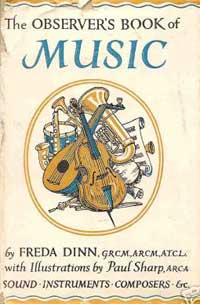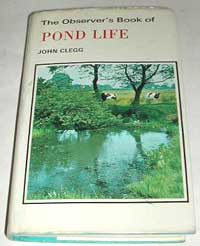Book Digest: January 29, 2007

Who doesn’t want to be an observer? Who wouldn’t like to notice something others overlook? For a few days I’ve been trying to come up with a single bad trait associated with being an observer, but like dolphins and rainbows, observers just seem wholly good. Which is why I am so fond of a quirky little set of books I found in a London bookshop several years ago.
Exactly the size and shape of a Moleskine notebook, the Observer’s series was started in 1937, with dozens and dozens of them appearing from Frederick Warne Publishers through the 1940s and ‘50s on nearly every topic imaginable: birds, dogs, horses, moths, heraldry and pond life, steam locomotives and soccer, lichens and firearms. The subjects are so varied it’s almost ridiculous, until you pick one up and realize how well the information is presented. They are so very British: compact, concise, courteous. From the chapter on sound in the Observer’s Book of Music: “The final question, why we should feel a sense of enjoyment in certain combinations of sounds, is a philosophical one, and cannot concern us here.”
Perfect. Never more than you want to know. Flipping through an Observer’s guide is like having a brief but fulfilling conversation with an expert in the field who wants to tell you only the best and most pertinent facts, with a few opinions scattered in for fun. From the entry on the Mexican orange blossom in my Flowering Trees and Shrubs: “It has proved to have a certain degree of hardiness for our gardens, remarkable in a plant of so warm a land.” Lovely. You know what he’s really saying? “We’re fucking lucky to have cultivated this beauty on our damp little island and you’d be a bleeding idiot not to plant it by your kitchen door tomorrow—or just as soon as you can propagate a cutting from a half-ripe shoot, usually June.”

Reading carelessly at first, perhaps even ready to mock (I mean, big bands? Coarse fishing?), you slowly begin to pay more attention until, lo and behold, you suddenly realize there are some very interesting things to know about castles and pottery, churches and house plants, even grasses and awards & medals. Each one has an introduction, rarely more than a few pages. All have an index and illustrations. The Observer’sBook of Trees has pretty endpapers with pale green drawings of seedlings. Of the ones I have, it is also the only one with a dedication: “For Camilla.” As for the illustrations, the ones in the books on natural history have excellent color drawings and black-and-white reproductions of photographs, but the composer portraits in the back of the guide to music are so rudimentary as to be embarrassing. Poor Henry Purcell looks as if he has a pair of mating badgers on his head; Gioacchino Rossini as if he hasn’t slept in years. Still, a review in the Birmingham Post quoted on the flyleaf of several editions says, “Information that is readily available at the time when it is wanted, in just the right quantity and of the right quality,” and this to me is their greatest attribute. What could be better, particularly in our messy, ballooning, endlessly linking, information age?
Most of the guides were updated and reprinted in the 1970s, and many of these editions carry a preface by the writer expressing the hope that his or her work will be found worthy of the Observer’s series, indicating the reverence with which these little gems must have once been held. Now they are out of print, found only by the lucky in used bookshops, or, if you become addicted (it’s a slippery slope), you can bid for them on eBay (in England and Ireland). I’m aiming for a complete set.
